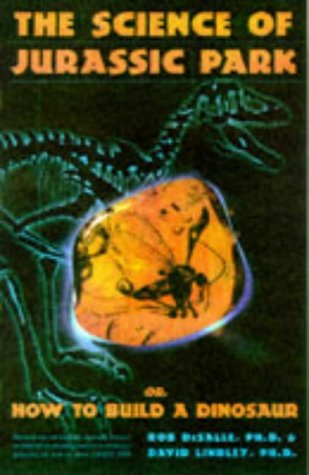Articoli correlati a The Science of Jurassic Park: and The Lost World: How...

How to build a dinosaur.
This book addresses the simple but exhilarating proposition: ‘if an insect which had bitten a dinosaur 85 million years ago had been preserved in amber, could modern scientists extract the DNA from the insect and use it to clone a dinosaur?’
Written in a way that is both authoritative and highly entertaining, The Science of Jurassic Park examines the scientific ideas that underpin the massively successful film.
Readers learn where to search for amber from the dinosaur age (hint: New Jersey or the Baltic States); how to identify DNA and how a cloned dinosaur would learn to behave if none of its kind were around to teach it.
Genetics for the uninitiated!
Le informazioni nella sezione "Riassunto" possono far riferimento a edizioni diverse di questo titolo.
Rob DeSalle is a curator at the American Museum of Natural History in New York and has isolated some of the world’s oldest DNA encased in amber.
David Lindley is a former editor of Science and Nature and author of the acclaimed End of Physics
Could it really happen? Could modern scientists using cutting-edge laboratory techniques really clone living, breathing, hungry dinosaurs and populate a true-to-life 'Jurassic Park'?
Prepare yourself for a deliciously fun-filled romp to that edge where the science fiction of today is approaching the hard science of tomorrow. You'll explore the possibilities with two scientists intimately familiar with this world: Rob DeSalle, an associate curator at the American Museum of Natural History in New York City, who isolated some of the DNA encased in amber, and David Lindley, a physicist and editor at 'Science News 'magazine.
Of course, 'Jurassic Park' and its sequel, 'The Lost World', skilfully combine hard science with literary license. But how much of each was in the mix?
Along with delightful and fascinating facts and factoids—including 'Jurassic Park' and 'The Lost World' movie bloopers—readers will learn: Why amber from the Dominican Republic, a Caribbean island, could never contain dinosaur DNA—and where you might try looking for the real thing.
How likely it is that you could extract dinosaur DNA from a mosquito that had lived at least 65 million years ago and had the misfortune, just seconds after it had indulged itself in a tasty swig of dinosaur blood, to be completely 'embalmed' – preserved in amber dripping from a nearby tree.
How scientists might go about getting a complete genetic blueprint of a long-extinct creature, and why they know that doing so is not enough to re-create life.
Why the hardest part of the process may be finding an egg that 'knows' everything a dinosaur egg would have known about turning DNA material into a living dinosaur.
Why a real Jurassic Park would have to be much more than a twenty-two square mile preserve – more likely an area about as big as the state of Connecticut.
Here is a book that fans of 'Jurassic Park, The Lost World', and dinosaur devotees everywhere will relish.
Rob DeSalle is associate curator at the American Museum of Natural History in New York City. In 1992, he isolated what was then the oldest known fragment of DNA. Physicist David Lindley, a former editor at both 'Science' and 'Nature' magazines and now an editor at 'Science News', is the author of 'The End of Physics' and 'Where Does the Weirdness Go?'
TEST YOUR 'Jurassic Park/ The Lost World' SCIENTIFIC IQ:
1. Where would author Michael Crichton and director Stephen Spielberg really have to go to get amber old enough to have a chance of containing dinosaur DNA? a) the Dominican Republic; b) the Nile delta; c) New Jersey?
2. When scientist Henry Wu shows visitors a fragment of 'dinosaur DNA,' is he showing them DNA from: a) a prehistoric dinosaur; b) a mosquito; c) a chicken; d) a bacterium; e) none of the above?
3. Who was the scientist who helped Michael Crichton, the author of 'The Lost World', get the genetic code for the protein 'eryf1,' and what trick did he play an Crichton? Hint: The DNA code for the protein specified in the book contains the hidden message 'MARK WAS HERE NIH.'
4. How many goats would really have to be killed each day to feed the meat-eating dinosaurs at 'Jurassic Park' (they were fed live...)?
Discover the answers to these and many other fascinating questions as you follow Rob DeSalle and David Lindley through an exploration of 'The Science of Jurassic Park and the Lost World'
Le informazioni nella sezione "Su questo libro" possono far riferimento a edizioni diverse di questo titolo.
- EditoreHarperCollins
- Data di pubblicazione1997
- ISBN 10 0002558939
- ISBN 13 9780002558938
- RilegaturaCopertina rigida
- Numero di pagine256
- Valutazione libreria
Compra nuovo
Scopri di più su questo articolo
Spese di spedizione:
EUR 21,29
Da: Canada a: U.S.A.
I migliori risultati di ricerca su AbeBooks
'THE SCIENCE OF ''JURASSIC PARK'' AND THE ''LOST WORLD'': HOW TO BUILD A DINOSAUR' DAVID LINDLEY' 'ROB DESALLE
Descrizione libro Hardcover. Condizione: New. Codice articolo XG-037

